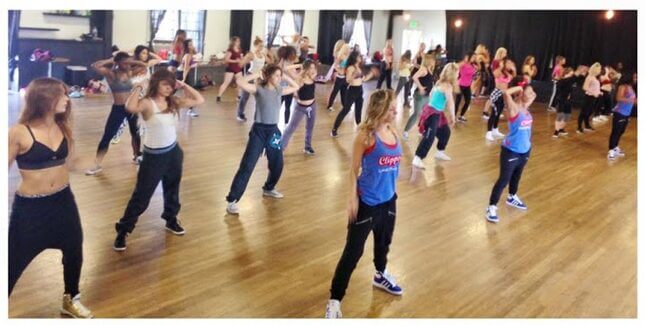I Went Undercover to Find Out What It Takes to Be an Underpaid NBA Cheerleader
Latest

A Clippers Spirit cheerleader named Candace taught us our first dance routine. On all fours, we whipped our hair around. This was my favorite part. Not thinking about everything I was doing wrong, I whipped my head so vigorously that one of my extensions came loose, and I skipped toward the back of the room to fix it. There, for the first time, I noticed that a man with a booze-bloated face and glazed over eyes was standing in the doorway staring at us.
I fixed my extensions and rejoined the group. We thrust our hips and counted off 8s. I forgot the arms and fumbled the turns. All around me, the women who could dance stood easily on top of the frantic beat. They picked up the choreography as quickly as it was thrown at us: complicated phrases in a language that had become their native tongue. It was difficult to remember that, for all this skill and effort, the end goal was a position that’s dramatically undervalued and dismissed. In general, it’s difficult to surmise exactly how worthless the NBA finds its cheerleaders, but I was at this workshop to give that question a shot.
Three other Spirit Team members—Brittany, Brooke, and Kellie—stood by Candace, helping her demonstrate. They would give us notes like “These arms are like, Okay?” and then run their hands from above their heads to across their chest and hips. Their eyes flashed inside jokes to each other; their bodies were all professionalism. After an hour and a half of relentless moving, learning, repeating, we got a 10-minute break, which we all used to touch up our makeup. Behind several girls taking selfies, Booze Bloat was escorted out of the building by studio staff.

This past year, the value of the average NBA team jumped 74 percent, bringing the median worth of teams across the association to $1.1 billion. Even the Milwaukee Bucks, the least valuable team in the NBA, are worth $600 million. The median ticket price to see any team play live is $53.98 and can be as high as $123.38 for a team like the New York Knicks. At these pricy games, one privilege that comes with buying top dollar floor level seats is to be greeted by cheerleaders as you walk through the door. Teams like the Brooklyn Nets offer a game night “experiences” with their dancers that start at $500 a package. And, according to former Golden State Warriors cheerleader Lisa Murray, NBA cheerleaders are “Working upwards of 30-35 hours, sometimes close to a 40 hours a week in the peak of the season… and only making minimum wage.”
None of the 30 NBA teams’ sites disclose their dancers’ salaries, though some, like the Orlando Magic’s, hint at the team’s “lots of hours, little pay,” policy by describing the position as “a part-time job that requires a full-time commitment.”
This year during playoff season, the NBA participated in a #LeanInTogether campaign, with popular players like Stephen Curry and LeBron James earnestly touting the benefits of wage equality between men and women. The league did nothing to raise the poverty-level wages of their cheer squads.
Exploitation of cheerleaders is prevalent across professional sports. Last year, multiple NFL teams, including the Raiders, Bengals, and Buccaneers faced lawsuits from cheerleaders who alleged they were paid less than minimum wage. The teams defended their actions on the grounds that the women were acting as independent contractors—free, ostensibly, to work as they please. But most pro cheerleading sites emphasize that attendance to every game and practice is entirely mandatory.
The concept of consulting work with mandatory attendance has been overturned in at least one state. This year, California Assemblywoman Lorena Gonzalez, herself a former collegiate cheerleader, introduced Assembly Bill 202, which required cheerleaders on professional sports teams in California to be treated as employees, and thus guaranteed at least a minimum wage. The bill passed in June of this year, so now the Golden State Warriors, valued at $1.3 billion, will have to pay their cheerleaders at least $9 an hour. (When contacted, a rep from the Golden State Warriors said that they did pay their cheerleaders at least minimum wage prior to the passage of AB202.)
I wanted to find out more about the working conditions of cheerleaders in my hometown of Los Angeles, where things seemed to be taking a turn for the progressive for the Clippers, a team that senile bigot Donald Sterling had been forced to sell to lovable liberal Steve Ballmer last year. I left multiple messages with the team’s corporate offices and heard nothing back. I contacted several members of the squad and Clippers Spirit director Audrea Harris, who coaches and manages the dancers. Radio silence. Then, while researching, I stumbled across a listing for a “Pre-Audition Workshop,” where aspiring Clippers Spirit Members could meet the squad, learn their choreography, and find out what it took to make the team.
-

-

-

-

-

-

-

-

-

-

-

-

-

-

-

-

-

-

-

-

-

-

-

-

-

-

-

-

-

-

-

-

-

-

-

-

-

-

-

-











































